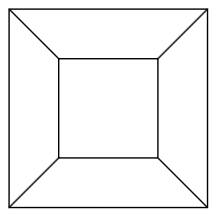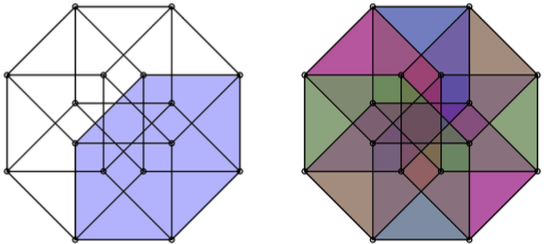Last week we counted vertices, edges, faces, and cells on a hypercube. Mainly, we thought by analogy — but how could we be sure our intuition was correct? Today, we look at another say to make these same counts, and obtain the same results. This suggests that maybe we were right all along….
So we begin by looking at the square and cube in a different way, and thinking (again) by analogy from there.
Let’s start with the number of edges on a square this time. We’ll start with one dimension less than the object we’re examining — later we’ll use the squares on a cube, and the cubes on a hypercube. Now to count vertices, we note that each edge has two vertices — for 4 x 2 = 8 vertices. But when we join the edges at vertices, two vertices merge, so we’ve overcounted by a factor of 2. Thus, there are 8 / 2 = 4 vertices on a square (as we know).
What happens when we look at the cube in the same way? Let’s start with the six squares. To count edges, we see that each square on the cube has 4 edges, for a total of 6 x 4 = 24 edges. But as with the vertices on the square, when we join two squares at their edges, two edges merge, so we’ve overcounted by a factor of 2. This means there are 24 / 2 = 12 edges on the cube.
For vertices, we note that three squares meet at each vertex. So there are 6 x 4 = 24 vertices on the 6 squares — but when we join the squares together, three vertices merge to one. This means we’ve overcounted by a factor of 3, so there are 24 / 3 = 8 vertices on a cube.
Now begin with the eight cubes on a hypercube. We note that the “8” comes from the sequence 2, 4, 6, 8,… for 2 vertices on a segment, 4 edges on a square, 6 squares on a cube, etc. On the square, we saw that 2 vertices merged. On the cube, we observed that 2 edges merged, then 3 vertices. By analogy, on the hypercube, we should have 2 squares merging, 3 edges, and 4 vertices. This pattern continues into higher dimensions as well.
Let’s use this analogy to check that we’ve counted correctly. First, we count squares. With 8 cubes, we have 8 x 6 = 48 squares. But since the cubes meet square-to-square, we’ve overcounted by a factor of 2, so that there are just 48 / 2 = 24 squares on a hypercube.
Now on to the edges. Since 8 cubes contribute 12 edges each, there are 96 edges in total. But three cubes meet at each edge, so we’ve overcounted by a factor of 3. This implies that there are in fact 96 / 3 = 32 edges on a hypercube.
Finally, we count the vertices. With 8 vertices on each of 8 cubes, we have 64 vertices all together. But four cubes meet at each vertex, so we have in fact overcounted by a factor of 4. This results in just 64 / 4 = 16 vertices on a hypercube.
So we counted correctly! Well, almost…. You might have noticed that we haven’t exactly defined what a hypercube is in a rigorous mathematical way. Until we do, the best we can say is that we’ve counted something, although we don’t know precisely what they something is at the moment. That will be a subject for a later post.
As you might expect, there are other ways to represent a hypercube besides the figure shown in last week’s post. We chose that particular representation because of the way we were thinking by analogy.
We’ll look at two additional ways. The first is analogous to looking at a cube face on, as shown below.

Of course the inner and outer squares are the same size on a cube — but we can’t help distorting faces of the cube when we make a two-dimensional sketch. Four of the squares are distorted into trapezoids here.
Here is the analogous representation of the hypercube.

In this figure, the inner cube (in green with black edges) is in fact the same size as the outer cube (with blue edges); these cubes are directly opposite each other on the hypercube. This is directly analogous to the inner and outer squares we saw in the earlier figure.
Further, note how the other six cubes are distorted into frustums of square pyramids — you can easily see the trapezoidal faces, which we also saw in the earlier figure. If you look carefully, you can count the 16 vertices and 32 edges. The 24 squares are a bit trickier — but begin with the 12 squares on the inner and outer cubes. Each of the other 12 squares contains exactly one black edge and exactly one blue edge — they are going “out” from the black edges to the blue edges. The perspective is different, but all the squares are there.
And of course there are the eight cubes — the inner cube, the outer cube, and the six frustums of square pyramids. All the elements of the hypercube are indeed present, but again, in a different perspective.
I did save the best for last — my favorite representation of a hypercube, shown below.

I just love the symmetry of this image — the octagram inside the octagon. If you look at the left image, you’ll see one of the eight cubes highlighted in blue. When each of the eight cubes is transparently colored in the right image, you’ll see an interesting overlap of colors.
Now let’s count the vertices, edges, faces, and cells in this figure. The 16 vertices are readily apparent in the inner octagram and the outer octagon. The 32 edges can be seen by counting eight edges from both the octagram and octagon, and two additional edges connecting each vertex of the octagon to two vertices of the octagram.
The squares are a bit trickier here as well — but eight are easily visible as undistorted squares sharing one edge of the octagon. But if you look carefully, you’ll also see 16 additional squares as rhombi in the figure. Eight of these rhombi each share two edges with the octagon, and the eight others each share two edges with the octagram. It might take staring for a minute, but they are all there.
And finally, there are the eight cubes. As seen in the left image, three consecutive edges of the octagon are enough to determine one of the cubes. Since we can take three consecutive edges of an octagon in exactly eight ways, we have found the eight cells on the hypercube.
So again, all the elements of a hypercube are present — it just takes looking from the right perspective to see them all.
Still remaining is to obtain the same counts by considering a rigorous definition of a hypercube. That for a later post….
One thought on “The Fourth Dimension, III”